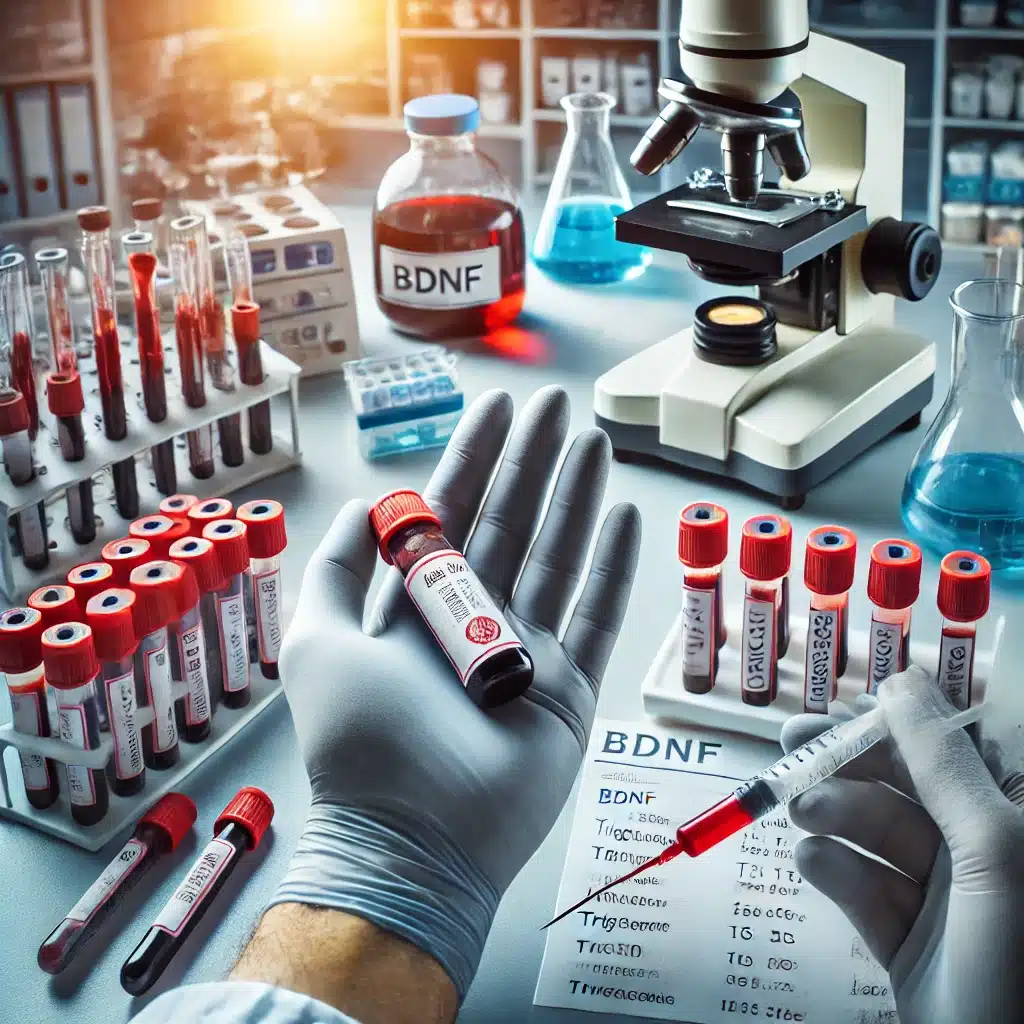The study found that higher levels of brain-derived neurotrophic factor (BDNF) and better cognitive function reduce suicidal thoughts in first-episode schizophrenia patients, while more severe symptoms and higher total cholesterol levels increase the risk.
Highlights:
- Suicidal Ideation Rate: 26.02% of first-episode schizophrenia patients had suicidal thoughts.
- Risk Factors: Higher total cholesterol (TC) levels and more severe symptoms (higher PANSS scores) increase the risk of suicidal thoughts.
- Protective Factors: Higher BDNF levels and better cognitive function (higher MCCB scores) lower the risk of suicidal thoughts.
- Prediction Accuracy: Combining BDNF, PANSS, and MCCB scores significantly improves the accuracy of predicting suicidal ideation in these patients.
- Study Sample: The study included 123 first-episode schizophrenia patients and 38 healthy controls.
Source: Brain & Behavior (2024)
Major Findings: Biomarkers to Predict Suicidal Ideation in First-Episode Schizophrenia (2024)
1. Suicidal Ideation Rate
The study revealed that 26.02% of patients experiencing their first episode of schizophrenia had suicidal thoughts, emphasizing the significant mental health risks associated with this condition.
2. Risk Factors for Suicidal Ideation
Total Cholesterol (TC) Levels
- Finding: Higher total cholesterol levels were linked to an increased risk of suicidal thoughts in patients.
- Implication: Monitoring and managing cholesterol levels may be crucial for mental health care in schizophrenia patients.
Severity of Symptoms (PANSS Scores)
- Finding: Patients with more severe symptoms, as measured by the Positive and Negative Syndrome Scale (PANSS), were at a higher risk of experiencing suicidal thoughts.
- Implication: Intensive management of schizophrenia symptoms is essential to reduce suicidal ideation.
3. Protective Factors vs. Suicidal Ideation
Brain-Derived Neurotrophic Factor (BDNF)
- Finding: Higher levels of BDNF, a protein associated with brain health and cognitive function, were protective against suicidal thoughts.
- Implication: Enhancing BDNF levels through potential treatments or lifestyle changes could help mitigate suicidal ideation.
Cognitive Function (MCCB Scores)
- Finding: Better cognitive function, as assessed by the MATRICS Consensus Cognitive Battery (MCCB), was associated with a lower risk of suicidal thoughts.
- Implication: Interventions aimed at improving cognitive function may play a role in preventing suicidal ideation.
4. Combined Predictive Value
Individual Indicators:
- BDNF: Area Under the Curve (AUC) of 0.630, with a sensitivity of 43.75% and specificity of 86.81%.
- PANSS: AUC of 0.724, with a sensitivity of 65.63% and specificity of 71.43%.
- MCCB: AUC of 0.762, with a sensitivity of 56.25% and specificity of 86.81%.
Combined Indicators: The combined AUC of 0.870 demonstrated that using BDNF levels, PANSS scores, and MCCB scores together provided a more accurate prediction of suicidal ideation.
Implication: Combining these measures can significantly enhance the ability to predict and potentially prevent suicidal thoughts in schizophrenia patients.
5. Demographic & Clinical Data Comparison
Demographics & Lipid Levels
- Finding: No significant differences in sex, age, marital status, years of education, or levels of LDL and HDL cholesterol between the schizophrenia group and healthy controls.
Triglycerides (TG) & BDNF
- Finding: Schizophrenia patients had higher triglyceride levels and lower BDNF levels compared to healthy controls.
- Implication: These biochemical markers could be indicative of underlying risks and protective factors in mental health.
Accuracy of Using Biomarkers with Standard Evaluations to Predict Suicidality in First-Episode Schizophrenia

The study assessed the accuracy of predicting suicidal ideation in first-episode schizophrenia patients using three main indicators: brain-derived neurotrophic factor (BDNF) levels, Positive and Negative Syndrome Scale (PANSS) scores, and MATRICS Consensus Cognitive Battery (MCCB) scores.
The accuracy was compared to standard methods, demonstrating significant improvements when these indicators were combined.
Receiver Operating Characteristic (ROC) Analysis
ROC analysis was employed to determine the predictive accuracy of each indicator and their combined use.
The Area Under the Curve (AUC) values were used to quantify the accuracy, with higher AUC values indicating better predictive performance.
Individual Predictive Indicators
1. BDNF Levels
- AUC: 0.630
- Sensitivity: 43.75%
- Specificity: 86.81%
Interpretation: While BDNF levels alone provided moderate predictive power, its high specificity indicates it is particularly effective in identifying those without suicidal ideation.
2. PANSS Scores
- AUC: 0.724
- Sensitivity: 65.63%
- Specificity: 71.43%
Interpretation: PANSS scores showed better predictive accuracy than BDNF, with balanced sensitivity and specificity, making it a more reliable single indicator for suicidal ideation.
3. MCCB Scores
- AUC: 0.762
- Sensitivity: 56.25%
- Specificity: 86.81%
Interpretation: MCCB scores had the highest AUC among the individual indicators, demonstrating strong predictive accuracy, particularly in identifying patients without suicidal ideation.
Combined Predictive Indicators
- Combined AUC: 0.870
- Youden Index: 0.588
- Sensitivity: 90.63%
- Specificity: 68.13%
The combination of BDNF levels, PANSS scores, and MCCB scores significantly enhanced predictive accuracy.
The combined AUC of 0.870 indicates a very high level of accuracy, outperforming each individual indicator.
The sensitivity of 90.63% suggests that the combined method is particularly effective in correctly identifying patients with suicidal ideation, while the specificity of 68.13% reflects a good ability to correctly identify those without suicidal ideation.
Cost-Effectiveness of Predicting Suicidal Ideation in First-Episode Schizophrenia

While the study highlights the enhanced accuracy of using BDNF levels, PANSS scores, and MCCB scores to predict suicidal ideation, it is also essential to consider the cost-effectiveness of this approach compared to standard methods.
Standard Methods
- Clinical Assessments: These are typically performed by psychiatrists or psychologists through interviews and observational techniques. Costs involve professional time and potentially multiple sessions.
- Self-Report Questionnaires: Tools like the Beck Scale for Suicidal Ideation (BSI) are inexpensive and quick but may lack objectivity and accuracy.
- Historical Data: Reviewing patient history is cost-effective but can be limited by the availability and accuracy of past records.
Costs of the Study’s Approach
1. BDNF Levels Measurement
Procedure: Requires blood sample collection and laboratory analysis using enzyme-linked immunosorbent assay (ELISA).
Cost: Laboratory tests can range from $50 to $150 per sample, depending on the facility and region.
2. PANSS Scores
Procedure: Administered by trained clinicians through a structured interview.
Cost: Involves clinician time, typically around 1-2 hours per patient, costing approximately $100-$300 per assessment session.
3. MCCB Scores
Procedure: Involves a battery of cognitive tests administered by trained personnel.
Cost: The full assessment can take 1-2 hours, with costs ranging from $200 to $500, including test materials and administration fees.
Cost-Effectiveness Analysis
Enhanced Accuracy: The combined approach’s high accuracy (AUC of 0.870) suggests that it is effective in preventing suicidal ideation, potentially reducing the need for emergency interventions and hospitalizations, which are far more costly.
Long-Term Savings: By accurately identifying at-risk patients, early interventions can be implemented, leading to better outcomes and lower overall healthcare costs. Preventing a single suicide attempt can save thousands of dollars in emergency care, psychiatric hospitalization, and long-term care.
Initial Investment vs. Long-Term Benefits: While the initial costs of BDNF testing, PANSS, and MCCB assessments are higher than some standard methods, the potential savings from reduced emergency interventions and improved patient outcomes can justify the investment.
Potential for Cost Reduction
Streamlined Testing: With technological advancements and economies of scale, the costs of biochemical tests like BDNF measurement may decrease over time.
Integration into Routine Care: Incorporating these assessments into regular patient evaluations can spread costs and enhance overall care quality without significant additional expenses.
Conclusion: Biomarkers + Clinical Symptom Scales to Predict Suicidality in Schizophrenia
This study demonstrates that combining brain-derived neurotrophic factor (BDNF) levels, Positive and Negative Syndrome Scale (PANSS) scores, and MATRICS Consensus Cognitive Battery (MCCB) scores significantly enhances the accuracy of predicting suicidal ideation in first-episode schizophrenia patients.
The combined approach, with an AUC of 0.870, outperforms standard methods, offering a robust tool for early identification and intervention.
Although the initial costs of these assessments are higher, the long-term benefits in terms of reduced emergency interventions and improved patient outcomes justify the investment.
Implementing these predictive measures in clinical practice could lead to better mental health care and safety for schizophrenia patients.
References









